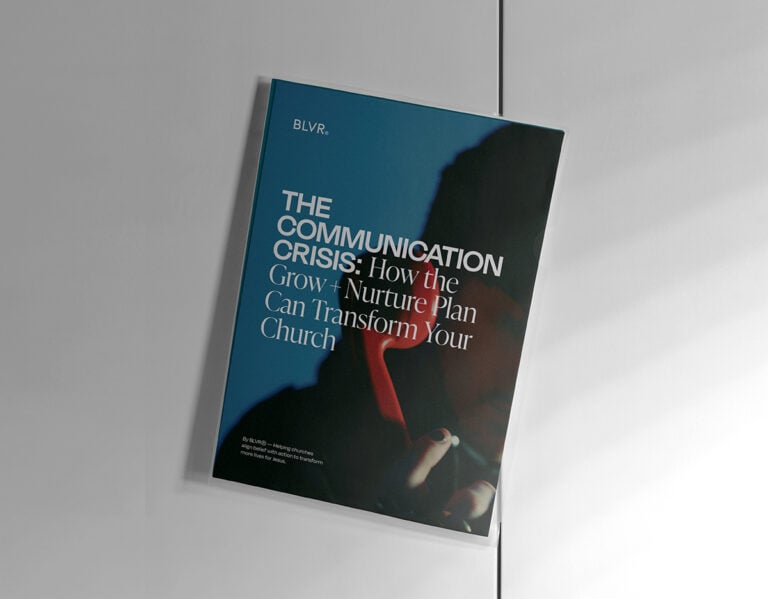
Church Branding / BY Adam Mcwethy
Your Church Has a Messaging Problem: Why One-Size-Fits-All Is Killing Your Impact
Published On 03.24.2025
Article
The Fatal Flaw in Your Ministry Strategy
Let’s face it — most churches today are operating with a glaring blind spot. When we’ve looked at how churches manage their contact lists, we’ve discovered something shocking: nearly everyone dumps their entire congregation into one massive bucket.
One bucket. For everyone.
No segmentation. No personalization. Just a jumbled mass of diverse people with diverse needs all receiving identical messaging.
Paul didn’t use one approach for everyone he encountered. He understood something critical that many modern churches are missing: different people need different approaches. It was for this reason that he sought to become all things to all people.
Here’s the painful truth many churches are facing today: Your community is beautifully diverse. Each person walks through your doors with unique challenges, different backgrounds, and varying places on their spiritual journey. Yet you’re communicating with all of them exactly the same way.
This is the Say-Do Gap® in action. You say you want to reach people where they are, but you do things with a one-size-fits-all approach.
The solution? Your messaging and outreach must be customized to speak directly to each person—the right message for exactly where they are. When you truly know who you’re communicating with, you craft sharper, more effective messages that move people through their spiritual formation. A church that understands its audience’s unique makeup can deploy strategies and tactics that provide better hope and more meaningful help to each segment.
When this Say-Do Gap closes, something beautiful happens: you connect more deeply with each person, building trust and fostering engagement that wasn’t possible before. The key takeaway is simple but profound: Your church cannot afford to speak the same one-size-fits-all message to your community. It simply doesn’t work.
The key takeaway is simple but profound: Your church cannot afford to speak the same one-size-fits-all message to your community. It simply doesn’t work.
“To the Jews I became like a Jew, to win the Jews. To those under the law I became like one under the law (though I myself am not under the law), so as to win those under the law. To those not having the law I became like one not having the law (though I am not free from God’s law but am under Christ’s law), so as to win those not having the law. To the weak I became weak, to win the weak. I have become all things to all people so that by all possible means I might save some. I do all this for the sake of the gospel, that I may share in its blessings.”
— 1 Corinthians 9:20-23
Why Generic Messaging Is Killing Your Impact
Here’s the brutal truth most church leaders don’t want to hear: your “one message for all” approach is failing spectacularly. This isn’t just marketing theory—it’s a cold, hard reality that’s emptying your pews.
People aren’t generic. They’re wildly and messily diverse with backgrounds, needs, and pain points as different as fingerprints. When your communication bulldozes over these differences, it doesn’t just miss the mark—it actively repels the very people you’re commanded to reach. They’re disengaging faster than you can say “amen,” and they’re looking elsewhere for spiritual or worldly guidance that actually speaks to their lives.
Think about it:
- A young professional craving authentic community doesn’t want the same message as a single parent desperately looking for childcare and encouragement.
- A teenager struggling with identity questions needs different spiritual nourishment than a senior facing end-of-life concerns.
Generic communication doesn’t just fail to connect—it actively alienates the very people you’re trying to reach.
I just finished reviewing HubSpot’s Annual State of Marketing Report for 2025, and the findings are clear: personalization isn’t just preferred, it’s expected. A staggering 96% of marketers report that personalized experiences increase engagement. The one-size-fits-all approach isn’t just outdated—it’s dead.
If your church is struggling to stand out, the problem isn’t that your message isn’t good—it’s that your audience doesn’t feel like you’re speaking directly to them.
The opportunity is clear: if your church is still trying to communicate with “everyone,” it’s time to refine. Narrowing your focus will help you connect more deeply, close spiritual gaps faster, and create better relationships with your community.
How Your Church Should Segment Its Audience
Where do you start? Let’s break down the most effective ways to segment your church audience:
First, consider segmenting by gender. Everyone who walks through your doors or visits your website is either male or female. This top-level segmentation immediately allows you to define who the audience is and get them into a dedicated flow with more personalized messaging that speaks to their unique spiritual challenges.
Next, segment by ages and stages. Kids, youth, young adults, and seniors all have vastly different needs and communication preferences. Your approach to reaching a 15-year-old should look nothing like your strategy for connecting with a 65-year-old.
Another critical distinction is between “the lost” and “the found”—those who don’t know Jesus (unchurched or dechurched) versus those who have accepted Him as their Savior and have an established relationship with Him.
Beyond these basics, a church also needs to account for the six stages people typically find themselves in:
- Current members of your congregation
- Prior members who’ve left
- New visitors exploring your church
- “Church seat swappers” who hop between congregations
- Those who grew up in church but haven’t attended since childhood
- People who have never known God at all
Finally, consider the various pain points that people within your community are struggling with: addictions, relationship issues, financial challenges, mental health concerns, and more. These real-life problems represent opportunities for your church to provide targeted support and hope.
Transitioning from Generic to Targeted Communication
Making this shift doesn’t have to be overwhelming. Start with these practical steps:
- Begin by adding groups for your top-level audiences within your CRM system. Instead of all your church contacts existing in one big group, set up separate segments for men, women, young adults, youth, and kids. Then you can layer in additional sub-groups as tags with your CRM for other ways you need to segment your people.
- Once these audience groups are established in your CRM, you can create and send personalized messaging to each unique segment. These tailored communications will be more fitting and better received because they speak directly to the specific needs and interests of each group.
This isn’t about making more work—it’s about making your work more effective. The same effort directed with precision yields significantly better results than scattered generic messaging.
Stop Settling for Mediocre Ministry Results
Let’s be blunt: your church absolutely cannot afford to continue with the one-size-fits-all approach. It’s spiritual malpractice. The evidence isn’t just clear—it’s screaming at you from both scripture and modern communication science. Personalized messaging doesn’t just “work better”—it’s the difference between a thriving, growing ministry and a slowly dying one.
It’s time for a gut-check. Ask yourself these uncomfortable questions:
- When was the last time you delivered a message specifically crafted for the men in your congregation?
- Have you addressed the raw, unfiltered struggles parents in your church face daily?
- Does someone battling anxiety or depression find real hope in your Sunday sermons?
If you’re squirming in your seat right now, congratulations—you’ve just identified a massive Say-Do Gap in your ministry. You say you want to reach everyone, but you’re doing almost nothing to speak their language.
Churches that have transformed their communication strategies from generic to personal have seen remarkable results. I personally began working with the church my family belongs to a few months ago to move away from a one-size-fits all bucket and into a contact list based on segmented audience groups. After the segmented audience lists were set-up, we began sending out a unique personalized weekly email to each audience group. All key metrics, including attendance and engagement, are up for each of my church’s audience groups; with the kids program up by a whopping 75%.
The apostle Paul understood that becoming “all things to all people” wasn’t about watering down the message—it was about delivering the same truth in ways that resonated with different audiences. Your church can do the same.
Ready to close the Say-Do Gap in your church’s communication? Start with just one segment this week. Craft a message specifically for them. Watch how they respond. Then add another segment next month. Before long, you’ll be speaking directly to the hearts of everyone in your community—one group at a time.
YOUR NEW COMMS PLAN
Learn how your church can apply an approach that businesses have used to successfully acquire new customers and retain existing customers. Use the power of audience segmentation to deliver personalized messages that are relevant to each person within you external and internal church community.

About the Author

Adam Mcwethy
Partner / COO
With almost 25 years of agency experience, Adam has worked with close to 500 brands, including Globe, World Vision, Marcus & Millichap, Creative Planning, and Liberty Station to name a few. Today Adam is focused on helping churches make a larger impact by attracting new guests and fostering deeper engagement from existing members. He is able to do this by bringing the insights he’s learned over the last two-decades of working with businesses to grow and retain their customers.
© BLVR
SD / CA




